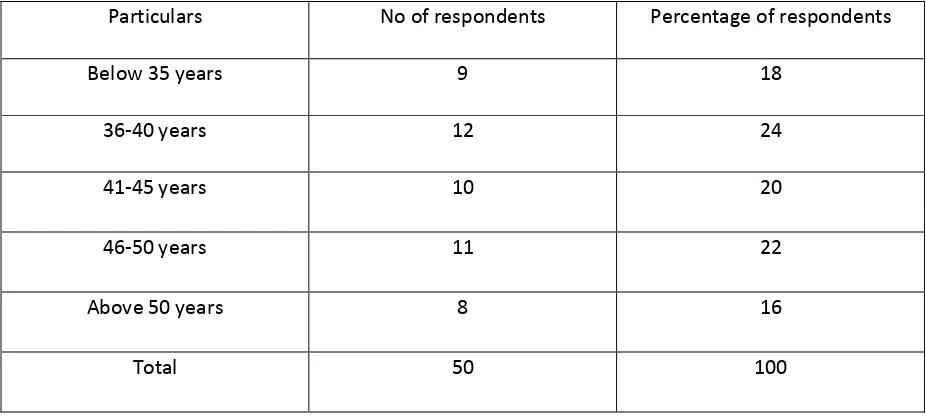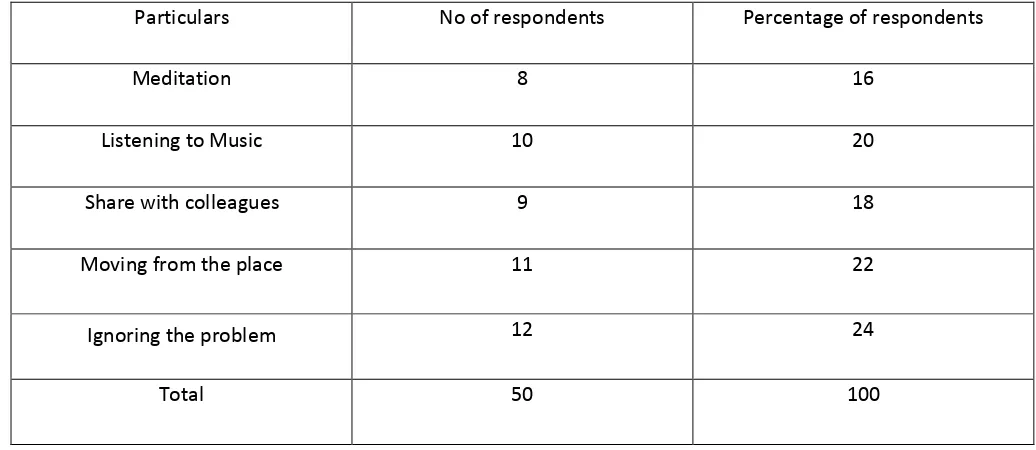A STUDY ON STRESS MANAGEMENT AMONG THE BANK EMPLOYEES IN TIRUNELVELI DISTIRCT AT TAMILNADU
A.Mahalakshmi, Assistant Professor,
Department of Business Management, Bharathiar University Arts & Science College, Valparai-
Dr.P.Jeyasri, Assistant Professor,
Department of commerce, ManonmiamSundaranar University College,Thisaiyanvilai.
C.Rajapal, Assistant Professor,
Department of Commerce (CA), Bharathiar University Arts & Science College, Valparai-642127
INTRODUCTION
Work plays a critical role in the lives of individuals which has contributed to the phenomenon of stress for both individual employees and the organizations. Stress, at work, is one of the traits in providing a healthy platform of work to employees. The stress induced due to roles performed by individuals as employees at the workplace, has been one of the most persuasive organizational stressors, the outcomes of which have been found to be costly to the organization. The highly competitive banking industry has levied varied role requirements on employees resulting in stress. This study, thus, aims at an exploration of the sources of role stress at commercial banks, identifying the coping strategies used by the employees, assessing whether the employees can be segmented on the basis of their role stress experiences, examining the determinants of role stress based employee segments, proposing a comprehensive model for the role stress phenomenon at commercial banks. The objectives have been met by an empirical study of the phenomenon of role stress of a sample of employees of commercial banks. The theoretical and policy implications of the findings of the study have been discussed which can facilitate the understanding and management of role stress at banks.
STRESS
Stress has often been misunderstood to be negative, with few people acknowledging the importance and usefulness of positive stress. In our everyday lives, stress is everywhere and definitely unavoidable; hence our emphasis should be on differentiating between what is good stress, and what is bad. This will help us to learn to cope with negative stress, and harness the power of positive stress to help us achieve more. There are four main categories of stress, namely eustress, distress, hyper stress and hypo stress. Negative stress can cause many physical and psychological problems, while positive stress can be very helpful for us.
The negative stress may lead to poor work performance. Job stress is also associated with various biological reactions that may lead ultimately to compromised health. Thus, Stress is inevitable in our society. Researchers on stress make it clear that, to enter into the complex area of stress, especially in the area of occupational stress, is very difficult. Stress is an unavoidable consequence of modern living. With the growth of industries, pressure in the urban areas, quantitative growth in population and various problems in day to day life are some of the reasons for an increase in stress. Stress is a condition of strain that has a direct bearing on emotions, thought process and physical conditions of a person.
The major features of stress are as given below:
1. Stress may result in any kind of deviation- physical, psychological, or behavioral – aspect of a person.
2. Stress may be the result of an individual’s interaction with environmental stimuli.
3. Stress is an inevitable part of life and it cannot always be avoided altogether.
4. Stress can either be temporary or long term, mild or severe, depending on how long its causes
continue, how powerful they are, and how strong an individual’ is for tolerating the Stress.
5. Stress is not always dysfunctional.
REVIEW OF LITERATURE:
Abdel-Halim (1978) examined the relative importance of role ambiguity, role conflict and role overload as a source of stress and dissatisfaction among managerial level employees. The results showed that role ambiguity has the strongest relationship with role responses. On the similar lines, Quah and Campbell (1994) studied role conflict and role ambiguity as factors in work stress among managers in Singapore and indicated that role conflict and role ambiguity are positively and significantly related to work stress among managers and work stress is negatively and significantly related to job satisfaction.
Douglas [1980], stress is defined as any action or situation that places special physical or psychological demand upon a person. Van Fleet [1988], stress is caused when a person is subjected to unusual situations, demands, extreme expectations or pressures that are difficult to handle.
Goyal and Joshi (2011) studied that M&As offer great opportunities for companies to grow and add value to shareholders’ wealth. Moreover, they have concluded that M&As are expected to increase in branches, market share, geographical reach or penetration in market, value and efficiency of the company and thereby increase shareholders’ value as we have observed in the case of ICICI Bank and the Bank of Rajasthan Ltd. Merger. Based on previous studies, we can identify the following merger stressors, which need to be studied in the present scenario of business
Rajeshwari (1992) identified the potent stress situations (stimulus) of bank employees and then classified them into factors relating to organizational policy, structure, process, physical working conditions, group behavior and others. They concluded that structural rigidity, poor physical working conditions and extra organizational factors be potent stressors.
Schweiger and Ivancevich (1985) studied the human factor in merger and acquisition and identified some common merger stresses, which include uncertainty, insecurity, and fears concerning job loss, job changes, compensation changes, and changes in power, status, and prestige. These stresses should be given utmost care in pre-merger strategic issues.
Shook and Roth (2011) conducted a qualitative study using a constant comparative method to assess the perspectives of HR practitioners based on their experiences with mergers, acquisitions, and downsizings. They interviewed 13 HR practitioners to collect the data. They found that HR practitioners were not involved in planning decisions related to downsizings, mergers, and/or acquisition. Neither the practitioners in this study, nor other members of the HR team in their organizations had an upfront due diligence role in these change initiatives.
OBJECTIVE OF THE STUDY
1. To analysis the job stress among the bank employees in Tirunelveli district. 2. To identify the level of stress among the bank employees.
3. To examine the coping strategy of stress among the bank employees.
METHODOLOGY OF THE STUDY
ANALYSIS
Table 1.1Gender wise classification
Particulars No of respondents Percentage of respondents
Male 24 48
Female 26 52
Total 50 100
Sources: Primary Data
From the table 1.1 out of the total respondents, 52% of the respondents are female and 48% of the respondents are male. Female respondents are taken more for the study because female respondents suffered by stress because they play dual role. They have both family stress as well as work stress.
Table1.2 Age wise classification
Particulars No of respondents Percentage of respondents
Below 35 years 9 18
36-40 years 12 24
41-45 years 10 20
46-50 years 11 22
Above 50 years 8 16
Total 50 100
Sources: Primary Data
From the table 1.2 it is understood that, out of the total respondents, 24% of the respondent belong to the age group of 36-40 years, 22% of the respondent belongs to the age group of 46- 50 years, 20% of the respondent belongs to the age group 41-45 years, 18% of the respondent belong to the age group below 35 years and 6% of the respondent belong to the age group of above 50 years. The majority of the respondents belongs to the age group of 36-40 years.
Table 1.3 Bank wise classification
Particulars No of respondents Percentage of respondents
Public sector 23 46
Private sector 27 54
Total 50 100
Sources: Primary Data
From the table 1.3 shows that, 54 % of the respondents are private bank employees and 46% of the respondents are public bank employees.
Table 1.4 Category wise classifications on stress
Particulars No of respondents Percentage of respondents
Stressed 37 74
Not Stressed 11 22
No commends 2 4
Total 50 100
Sources: Primary Data
From the table 1.4 shows that 74 % of respondents are met with stress, 22% of the respondents are not met with stress and 4% of the respondents are not willing to give their commands.
Table1.5 Classification of causes of stress
Particulars No of respondents Percentage of respondents
Work atmosphere 14 28
Lack of skill 12 24
Work life imbalance 17 34
Lack of staff co-ordination 7 14
Total 50 100
From the Table 1.5 shows that out of total respondents, 34% of the respondents reveals that the main causes of stress is a work life imbalance, 28% is by work atmosphere, 24% is by lack of skill and 14% is by lack of staff coordination. The majority of causes of stress is by work life imbalance.
Table 1.6 Classification on coping strategy of stress
Particulars No of respondents Percentage of respondents
Meditation 8 16
Listening to Music 10 20
Share with colleagues 9 18
Moving from the place 11 22
Ignoring the problem 12 24
Total 50 100
Sources: Primary Data
From the Table 1.6 revealed that out of total respondents, 24% of the respondents say that ignoring the problem is the best coping strategy, 22% is moving from the place, 20% by listening to music, 18% by sharing with the colleagues and 16% by meditation. Ignoring the problem is the best coping strategy on stress.
Conclusion
REFERENCES
Akinboye J.O., Akinboye D.O. and Adeyemo D.A., Coping with Stress in Life and at Workplace, StirlinHordon Publishers Ltd. (2002), pg.15.
Enekwe, Chinedu Innocent1*; Agu, Charles Ikechukwu2 and Eziedo Kenneth Nnagbogu3 1 & 2. Department of Accountancy, Faculty of Management and Social Sciences,
CaritasUniversityAmorji-Nike, Enugu State, Nigeria.
Fernandes, C. F. V., Kumar, S., AndMekoth, N. (2009), “Gender Differences in Stress among Bank Officers of Private and Public Sectors”, The ICFAI University Journal of Organizational Behavior, Vol. VIII, No. 2, pp. 63-69
Hasnain N., Shahnawaz M.G. and Shukla V., Role stress and coping strategies in different occupational groups, I.P.R. Special Millennium Issue (2001)


